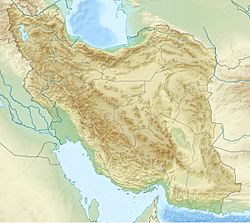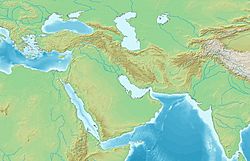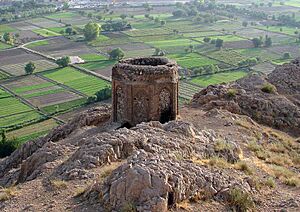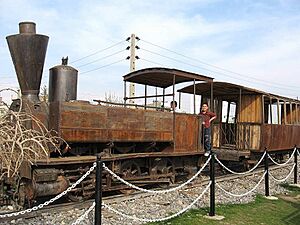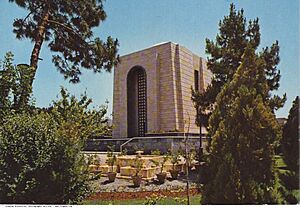Ray, Iran facts for kids
Quick facts for kids
Shahr-e Rey
ری
|
|
|---|---|
|
District of Tehran
|
|
|
From top; left to right: Tughrul Tower, Shah Abdol-Azim Shrine, Rey Castle, Bahram Fire Temple, Rashkan Castle and Bibi Shahrbanu Shrine.
|
|
| Country | Iran |
| Province | Tehran Province |
| County | Ray County, Tehran County |
| Area | |
| • Total | 2,996 km2 (1,157 sq mi) |
| Elevation | 1,180 m (3,870 ft) |
| Population
(1996)
|
|
| • Total | 250,000 |
| • Density | 83.4/km2 (216/sq mi) |
| Time zone | UTC+3:30 (IRST) |
| • Summer (DST) | UTC+4:30 (IRDT) |
| Area code(s) | 021 |
Shahr-e Rey (which means "City of Rey" in Persian) is a very old city in Iran. It is now part of Greater Tehran, the capital city. You can find it in Tehran Province.
In the past, Shahr-e Rey was known by names like Rhages and Arsacia. It is the oldest city still existing in Tehran Province. Long ago, it was an important city in a region called Media. This area was a political and cultural center for the Medes, an ancient Iranian group. Old writings and religious books show how important ancient Rey was.
Sadly, the city faced a lot of damage during invasions in the Middle Ages. But it became important again under the Buyid and Seljuk empires. Rey has many historical sites, like the ancient Cheshme-Ali hill and the Bahram Fire Temple.
Many famous people, including scientists and poets, came from Rey. One of them was Rhazes, a very important doctor and scholar from the Middle Ages. Today, Rey has many factories and industries. It is connected to the rest of Tehran by the Tehran Metro system.
Contents
Exploring Rey's Geography
Mountains Around Rey
Rey County is mostly flat, so its mountains are not very tall. Here are some of them:
- Bibi Sharbanu Mountain: This mountain is east of Rey City. It is about 1,535 meters (5,036 feet) above sea level.
- Arad Mountain: Located in the center of Rey County, this mountain is 1,428 meters (4,685 feet) high. It was even shown on an old map from 1890.
- Mar_e Mountain: This mountain is southwest of Rey City. It is 1,503 meters (4,931 feet) tall.
- Kūh-e Qarah Bologh: This mountain is where four cities meet: Zarandiyeh, Saveh, Rey, and Qom.
Rivers Flowing Through Rey
Rey has a few important rivers:
- Karaj River: This river starts in the Alborz Mountains. It flows through several cities in Tehran Province before reaching the Salt Lake. It is the second-largest river in this central region.
- Jajrud River: This is another important river in Tehran province. A part of this river flows along the eastern edge of Rey City. It also ends up in the Salt Lake.
- Shur Fashapoye River: This river starts in Zanjan province and flows for 420 kilometers (260 miles). It crosses Rey City from northwest to southeast.
Plants and Green Spaces
Rey has a semi-desert climate. This means it does not have natural forests. However, people have planted about 387 hectares (956 acres) of trees. The area is also rich in pastures, with about 166,200 hectares (410,700 acres) of land for grazing animals.
What's in a Name?
The name Shahr-e Rey means "City of Ray" in the Persian language. The name Ray comes from an old Persian word, Ragā, which might be related to the Persian word for "red."
In ancient Greek, the city was called Rhágai or Rháges. In Latin, it was known as Rhagae. For a while, during the Seleucid Empire, it was even called Europos.
You might see the name spelled in different ways, like Ray, Rey, Rayy, or Rhay. The Encyclopædia Iranica usually uses Ray. In the past, people from Ray were called "Razi."
A Look at Rey's Long History
People have lived in Rey for a very long time. Early farming communities settled here around 6,000 BC. Some stories say that ancient kings founded Rey. It is also believed that Rey was once a center for Zoroastrian leaders.
Ancient Times
Rey is mentioned in ancient writings from the Achaemenid Empire. It was part of Media, a key region for the ancient Medes.
Rey was an important city for the Seleucid Empire. A general of Alexander the Great, named Seleucus I Nicator, even renamed the city Europos. Later, around 148 BC, the Parthian king Mithridates I took over Rey. The Parthians renamed it Arsacia. Rey remained important to the Parthians, even serving as one of their changing capital cities. It helped them stop attacks from nomadic groups.
Under the Sasanian Empire, Rey was near the center of the empire. It was home to powerful families, like the House of Mehran.
The Middle Ages
In 643 AD, the last King of Rey from the Sasanian Empire was defeated during the Muslim invasion. Rey then became a camp for the Arab army. Later, during the Abbasid Caliphate, Rey was rebuilt and grew into a new city called Mohammadiya. People in Rey at this time spoke a language called Razi.
The Shah Abdol-Azim Shrine was built in the ninth century. It holds the tomb of Abd al-Aziz al-Hasani, a relative of Hasan ibn Ali. This shrine is still the main religious site in the city today.
In the tenth century, a wealthy person in Rey built a Tower of Silence. This was a place where Zoroastrians would leave the bodies of the dead. Today, this tower is in ruins.
Also from the tenth century is the Bibi Shahr Banu Shrine. This place was once a Zoroastrian temple dedicated to Anahita, an ancient Iranian goddess of water. It was later turned into a Muslim shrine. Many believe it is the burial place of Shahrbanu, a legendary princess.
Rey was one of the capital cities of the Buyid dynasty. It also had a fast postal service for official messages.

In the 11th century, Rey was also a capital city for the Seljuk Empire. During this time, Rey was at its largest. It had a big market that helped nearby towns, including the small town of Tehran. Rey became famous for silk weaving. Goods from the Silk Road were brought to Rey's market. The 12th-century Tughrul Tower is a monument from this time. It was built around 1140 and is linked to Tughrul I, who started the Seljuk Empire.
Rey had a Shia Muslim community and some of the first Shia schools in Iran in the 12th century.
In the early 13th century, Rey was badly damaged during the Mongol invasion of Iran. The city was left empty and lost its importance as Tehran grew nearby. Rey remained abandoned during the time of the Timurid Empire.
Early Modern Times
In the 1600s, an Italian writer named Pietro Della Valle described Rey as a large city with big gardens. However, it did not seem to have many people living in it.
Important religious shrines in Rey, like the Shah Abdol-Azim and Bibi Shahrbanu shrines, were rebuilt during this period. New building styles were used from the Safavid and Qajar dynasties.
There is a stone carving at Cheshme-Ali from the time of Fath-Ali Shah of the Qajar dynasty. It shows the Qajar ruler hunting. This carving replaced an older one from the Sasanian period. It was made in 1831.
Modern Times
In the mid-1800s, Rey was mostly ruins, except for the area around the Shah Abdol-Azim Shrine. Because it was the only important pilgrimage site near the new capital, Tehran, more people visited. The royal court helped pay for a major restoration.
Between 1886 and 1888, under Naser al-Din Shah, Rey became the first place in Iran to have a railway connection to the capital. This short railway used steam trains, which people called "smoky machines."
Archaeologists started digging in the old city in the late 1800s. Many things they found were traded. From 1933 to 1936, archaeologists from American universities excavated the Cheshme-Ali hill. They found 7,000-year-old artifacts. Some of these items are now in museums in Iran and the United States. Due to building projects in the 1980s and 1990s, much of the hill is now flat. More excavations began in 1997.
In 1951, Reza Shah of the Pahlavi dynasty, a former ruler of Iran, was buried in a mausoleum in Rey. His son, Mohammad Reza Pahlavi, ordered it built near the Shah Abdol-Azim Shrine. After the 1979 Revolution, the mausoleum was destroyed.
Rey's Climate
Rey has a cold semi-arid climate. This means it has dry summers and cold winters.
| Climate data for Shahre-Rey | |||||||||||||
|---|---|---|---|---|---|---|---|---|---|---|---|---|---|
| Month | Jan | Feb | Mar | Apr | May | Jun | Jul | Aug | Sep | Oct | Nov | Dec | Year |
| Mean daily maximum °C (°F) | 9 (48) |
12 (54) |
17 (63) |
24 (75) |
29 (84) |
36 (97) |
38 (100) |
37 (99) |
33 (91) |
26 (79) |
17 (63) |
11 (52) |
24 (75) |
| Mean daily minimum °C (°F) | 1 (34) |
3 (37) |
8 (46) |
13 (55) |
18 (64) |
23 (73) |
26 (79) |
25 (77) |
21 (70) |
15 (59) |
8 (46) |
4 (39) |
14 (57) |
| Average precipitation mm (inches) | 29.8 (1.17) |
30.5 (1.20) |
37.3 (1.47) |
32.0 (1.26) |
9.2 (0.36) |
5.4 (0.21) |
7.1 (0.28) |
5.0 (0.20) |
1.0 (0.04) |
9.9 (0.39) |
26.4 (1.04) |
24.7 (0.97) |
218.3 (8.59) |
| Source: NOAA | |||||||||||||
Famous People from Rey
Many notable people have come from Rey, including:
- Muhammad ibn Zakariya al-Razi: A famous Persian doctor, philosopher, and alchemist.
- Abu Hatim Muhammad ibn Idris al-Razi: A major Sunni Hadith scholar.
- Abu Zur’ah Ar-Razi: Another important Sunni Hadith scholar.
- Amin Razi: A Persian geographer.
- Harun al-Rashid: An Abbasid caliph.
- Fakhr al-Din al-Razi: A theologian and Qur'an interpreter.
- Najmeddin Razi: A Persian mystic.
- Morteza Avini: An Iranian documentary filmmaker.
- Javad Nekounam: A well-known Iranian football player.
- Hadi Saei: A famous Iranian taekwondo athlete.
- Alireza Dabir: An Iranian wrestler.
- Hamid Sourian: An Iranian wrestler.
- Mehdi Kamrani: An Iranian basketball player.
Images for kids
-
A 1818 map of Ray by Scottish traveler Robert Ker Porter.
-
A 1840 depiction of the 12th-century Seljuk-era Tughrul Tower of Ray by French orientalist Eugène Flandin.
-
Ibn Babawayh Cemetery, named after Shia scholar Ibn Babawayh, in Ray.
See Also
 In Spanish: Rayy para niños
In Spanish: Rayy para niños








